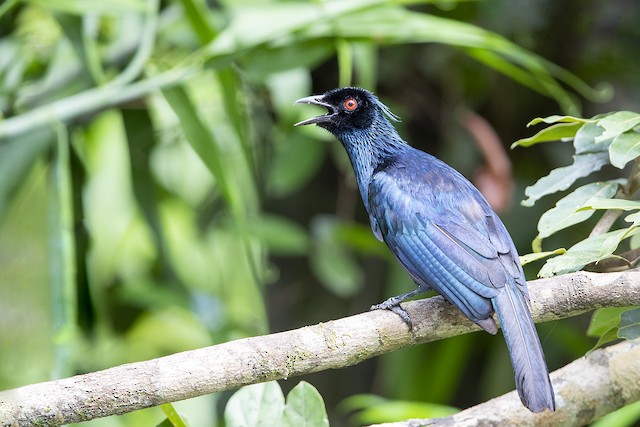Trumpet Manucode are aberrant birds of paradise that breed in monogamous pairs, lack patches of metallic color, and have, in males, a long coiled windpipe running under the skin over the muscles of the breast.
This coiled windpipe apparently produces their loud carrying territorial croaks and squeaking jars. Limited in Australia to the tropical hill and lowland rainforests of Cape York Peninsula, Trumpet Manucode spend much of its time feeding on the forest canopy.
They are fruit-eaters-although taking occasional insects and larvae-and they bound and fly through the treetops with jerky, heavy-footed furtiveness, twisting and craning, never still. Following fruiting trees, they are locally The Trumpet Manucode lives in rainforests on the Cape York Peninsula.
Disappearing and then congregating in twos to fives at flushes of food. But they do not migrate to New Guinea. Males hold territory, marking it with loud croaks from high perches. Courtship is spectacular.
Male chases female, both landing from time to time on high exposed branches. There the male faces his mate, crouches, fluffs his feathers into a ball, and spreads his wings, trumpeting. The female responds with soft chirping. Both sexes share incubation and the feeding of the young and often site their nests close to those of Black Butcherbirds.
They will also usurp the new nests of other birds but probably without relying on the original owners to brood and rear their young. The other names are Trumpet Bird, Manucode, and Australian Bird of Paradise. The size of a Trumpet Manucode is about 280-320 mm in length.
ADULTS: Sexes are similar; the male is larger, more brightly glossed with longer plumes on the back of the head. Plumage black glossed all over with oil-green, sometimes tending to purple, except underwings and tail. Feathers of the nape, neck, and throat are narrow, long, and pointed, forming slender tufts of plumes on each side of the back of the head.
The eyes are vermilion along with the bill and the feet are black. IMMATURES: Less glossy than adults, plumage softer; head plumes shorter; slightly smaller.
Trumpet Manucode call is a single, loud, deep croak Gronk, repeated at intervals for contact, identification, and marking territory by male; low, drawn-out aaa-a-a-a-a like heavy door squeaking, probably by the male. Trumpet Manucode’s song consists of loud trumpeting the display, by males. Female response with soft chirping chee-eee. Trumpet Manucode nesting and breeds mainly October-January; possibly sporadically throughout the year.
Nest an open, shallow, flimsy cup, about 170 mm across x 110 mm deep, of vine tendrils and twigs; lined with similar materials; placed 10-20 m up too often more, upright to a horizontal fork in the canopy of tall rainforest trees.
Eggs: one or two; very pale dull purplish pink, spotted and finely blotched all over with red-brown, umber, and violet-grey, often in the zone at the larger end; oval, about 37 x 24 mm. The incubation period is 15-16 days, for both sexes. Trumpet Manucode is found in pockets of rainforest from Cape York southwards to Rocky River and Mcilwraith Range, and also in New Guinea and on Aru Islands. Moreover, six or seven races; one endemic in Australia.
Read More – Wandering Albatross








